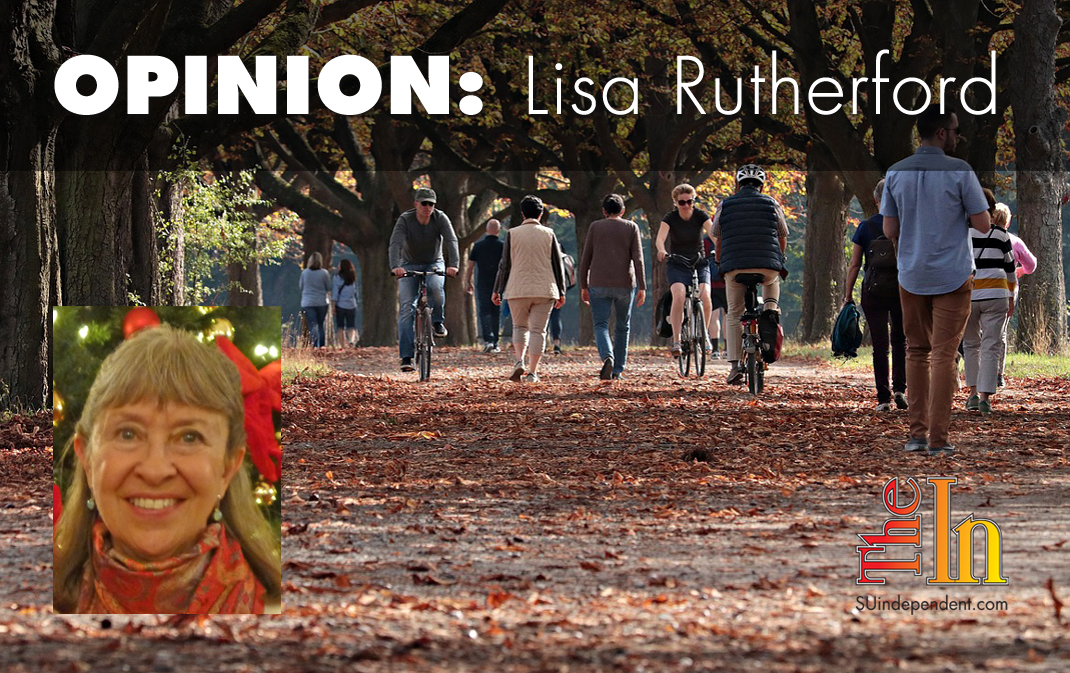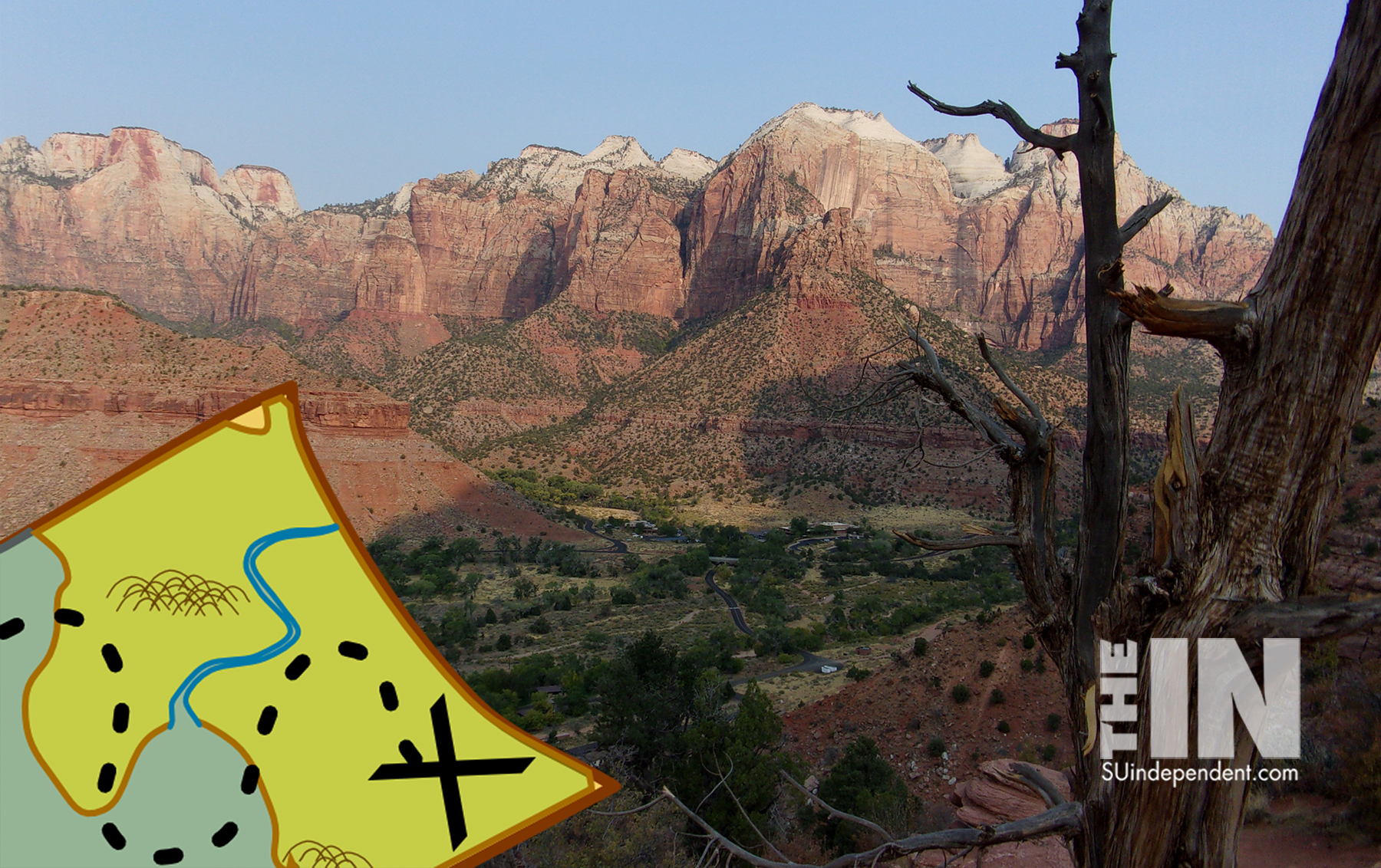
Trees or lawns: Which will provide a better future?
For the 12 years during which I’ve been studying the proposed Lake Powell Pipeline — reading articles and studies, attending meetings, and writing — there has been a constant refrain from LPP proponents when the issue of lawn removal comes up: We need grass because without it more energy will be needed to cool homes, adding to residents’ home costs. Additionally, this area has prided itself on its lush landscaping and abundant golf courses, helping to balance the red rock vistas with lovely verdant green.
But is grass the only way to achieve that look in our urban environment? Is grass the best way to ensure a water-wise, sustainable future? Or are there other ways to achieve lower temperatures and save energy?
State reports for 2015 and 2018 reveal that citizens overwater outside. The Washington County Water District publication 2014 Summer Water Line revealed that 61 percent of our residential water use goes outside, mostly on grass, and most of that is culinary (potable) water. Information currently on the district’s website — information that includes residential and institutional, commercial, and industrial water use — reveals that 58 percent of water is used outside, again most of that culinary.
Clearly, a lot of “drinking” water is being used to maintain lawns, water that could be used to “maintain” people instead. If people like lush green and holding down temperatures and energy costs, what’s another option?
Trees.
As our urban area grows, decisions concerning how our precious water should be used will be critical. Currently, our high overall usage — around 303 gallons per capita per day, much more than other desert cities — is obviously being driven by high water use on lawns, encouraging a perceived need for the Lake Powell Pipeline.
One study done at UCLA, “Water Use by Urban Lawns and Trees in Los Angeles,” specifically compared water use by trees and turfgrass in the L.A. area. The study revealed that trees use less water than unshaded turfgrass. The study also revealed that L.A. lawns accounted for 70 percent of the total water used on landscapes that consumed nearly 100 billion gallons of water per year. Certainly, this is important to keep in mind as our area grows.
Water, has become an important issue, particularly in the desert southwest and west. Many studies regarding the “urban heat effect” have been conducted. City growth results in more blacktop, concrete, and other materials that add heat by absorbing solar radiation during the day, much of it released at night into the air, creating a warm bubble and compounding the problem. Comparing the effects of trees and grass on temperature and the associated energy needed to cool buildings is very complex. Issues such as evapotranspiration — the transfer of water evaporating from the soil and transpiration from plants in that soil to the air — solar radiation, wind speed, and more must be considered.
A 2015 study by a landscape and urban planning organization focused on urban greening infrastructures states, “In most cases, tree canopies are the optimal solution for shading both canyon surfaces (areas between buildings) and the pedestrian space, and they also provide evapotranspirative cooling.” As climate change progresses and adaptation is required, any urban greening infrastructure, they advise, should determine key objectives; temperature mitigation is only one. The report emphasized that much work remains to be done to determine optimal urban greening infrastructure arrangement for a particular situation, but there is sufficient information available for local governing bodies to take positive action to help mitigate rising temperatures.
Another report, “The cooling efficiency of urban landscape strategies in a hot dry climate,” noted, “Unshaded grass was found to cause only a small air temperature depression and had the highest water requirement.”
Whether we believe climate change to be manmade or not, the effects are being felt and must be dealt with.
“The effect of tree shade and grass on surface and globe temperatures in an urban area,” a study done on lawns and trees, revealed “that both grass and trees can effectively cool surfaces and so can provide regional cooling, helping reduce the urban heat island in hot weather. In contrast grass has little effect upon local air or globe temperatures, so should have little effect on human comfort, whereas tree shade can provide effective local cooling.”
Another study, “Comparing Cooling Effects of Trees and Lawns in Phoenix: Implications to Building Energy Consumption,” stated, “Results reveal that trees can significantly decrease canyon temperature in summer and promote building energy efficiency due to shading effects. Comparisons also indicate that the shading effect is more prominent than evapotranspiration.” Grass provides no shading effect, only evapotranspiration.
Finally, a 2017 study, “A Methodology for Calculating Cooling from Vegetation Evapotranspiration for Use in Urban Space Microclimate Simulations,” emphasized, “In general, surface shading is usually more effective than evapotranspiration in reducing building energy use.…”
This is not to say that lawns do not provide some measure of cooling. But given the amount of water needed and the overwatering we currently see in our area, lawns are not the best choice.
However, there are challenges with using trees also. Our area has a growing ozone problem. More cars and use of lawn equipment create emissions that add to the problem. Volatile organic compounds, also known as biogenic volatile organic compounds, are the culprits. When combined with heat and emissions, ozone is increased. Although people vary in their susceptibility to ozone’s effects, even healthy people as well as people with respiratory issues can be affected.
A 2012 study done by the University of California identified a variety of trees with high and low biogenic volatile organic compound levels. Poplars and willows were identified as problem trees with high levels. The study adds that this does not mean that these trees and others should not be used; however, it does mean that they should be used with care in an area with ozone problems while trees with low biogenic volatile organic compound levels should be given greater consideration. Desert willow, mimosa, thornless honey locust, and chitalpa are examples of trees with low biogenic volatile organic compound levels.
Also, placement of trees is important to provide proper shading and obtain maximum benefit. Both lawns and trees act as carbon sinks — absorbing carbon from the atmosphere — to help counter global warming. Many studies are being done on how well each succeeds.
These are complex issues requiring further study. And I haven’t even touched on the pollen issue for both lawn and trees that needs to be considered. However, instead of just plopping down a lawn and giving little thought to the matter, residents and leaders need to learn more and set a new course — and not “golf.” Given what we now know, lawns should not be our future; trees should.
For a list of the benefits of trees, go to projects.ncsu.edu/project/treesofstrength/benefits.htm.
The viewpoints expressed above are those of the author and do not necessarily reflect those of The Independent.
How to submit an article, guest opinion piece, or letter to the editor to The Independent
Do you have something to say? Want your voice to be heard by thousands of readers? Send The Independent your letter to the editor or guest opinion piece. All submissions will be considered for publication by our editorial staff. If your letter or editorial is accepted, it will run on suindependent.com, and we’ll promote it through all of our social media channels. We may even decide to include it in our monthly print edition. Just follow our simple submission guidelines and make your voice heard:
—Submissions should be between 300 and 1,500 words.
—Submissions must be sent to editor@infowest.com as a .doc, .docx, .txt, or .rtf file.
—The subject line of the email containing your submission should read “Letter to the editor.”
—Attach your name to both the email and the document file (we don’t run anonymous letters).
—If you have a photo or image you’d like us to use and it’s in .jpg format, at least 1200 X 754 pixels large, and your intellectual property (you own the copyright), feel free to attach it as well, though we reserve the right to choose a different image.
—If you are on Twitter and would like a shout-out when your piece or letter is published, include that in your correspondence and we’ll give you a mention at the time of publication.
Articles related to “Trees or lawns: Which will provide a better future?”
What gifts and lessons will we leave our children and grandchildren?
Water Conservancy District should get a lump of coal this Christmas, not more of our taxes
Northern Corridor is not the only threat to our beloved Red Cliffs Desert Reserve



